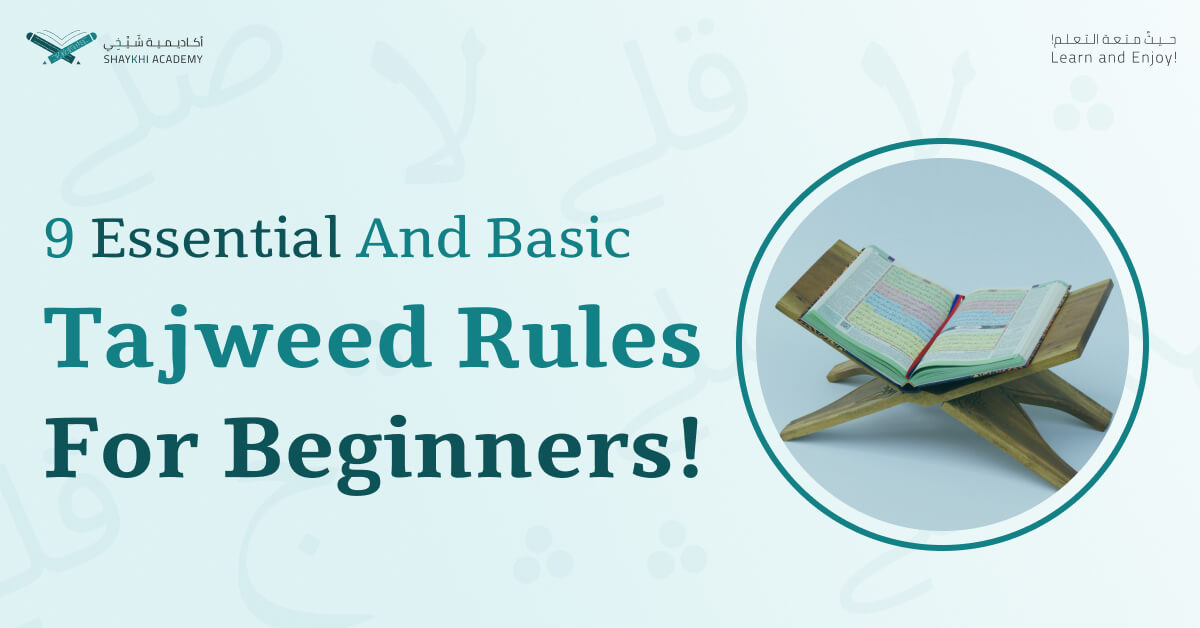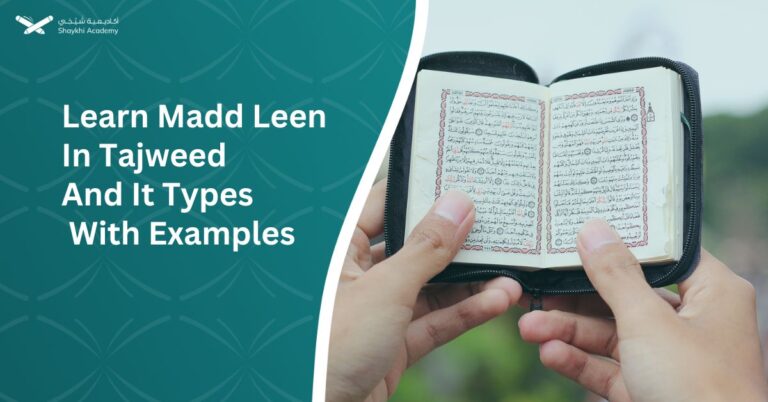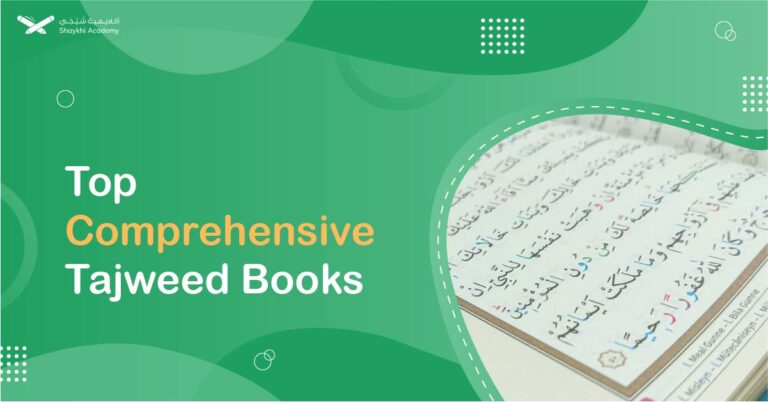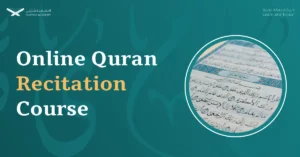In this article, we will talk about some basic Tajweed rules that you must know in order to have the correct pronunciation of the Qura’nic words and improve your recitation skills
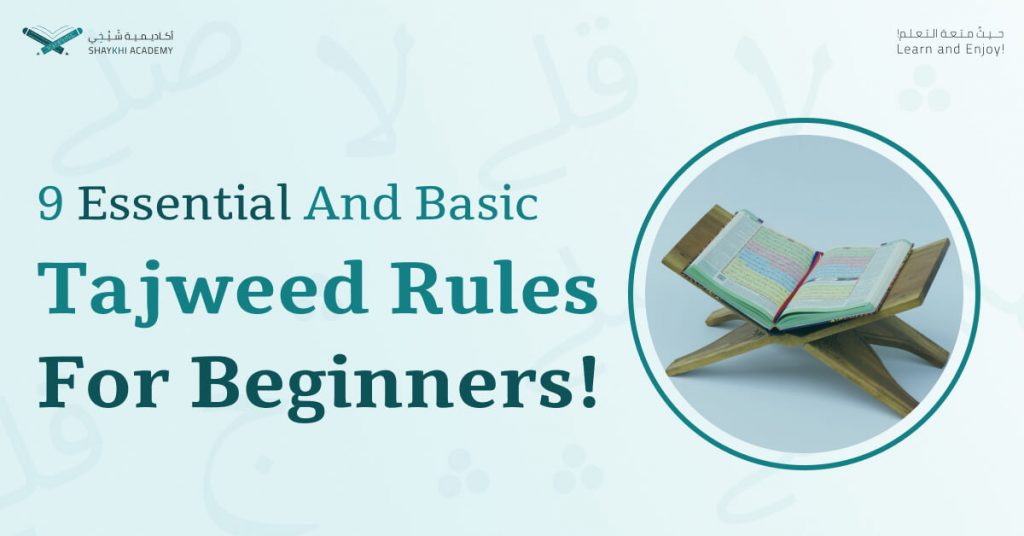
Tajweed And Its Rules
“Tajweed” in the Arabic language means improvement and excellence. And it is a science that looks into how to pronounce the words of the Holy Quran correctly as well as everything related to it. Such as Waqf and Ibtidaa (Stopping And starting), or Wasl and Qat’ (Connecting and cutting) which divides Tajweed into 2 basic parts. The first part is the theoretical Tajweed which is about the rulings’ intellectual aspects that’s if enough Muslims fulfill it, it falls from the rest because it is a sufficient duty. And the second part is the practical Tajweed which looks into the correct reading of the holy Quran, and it is a must for all Muslims to learn and fulfill.
The Basic Tajweed Rules

“وَقَالَ ٱلَّذِينَ كَفَرُوا۟ لَوْلَا نُزِّلَ عَلَيْهِ ٱلْقُرْءَانُ جُمْلَةًۭ وَٰحِدَةًۭ ۚ كَذَٰلِكَ لِنُثَبِّتَ بِهِۦ فُؤَادَكَ ۖ وَرَتَّلْنَـٰهُ تَرْتِيلًۭا
— Surah Al Forqan Ayah (32)
And those who disbelieve say, “Why was the Qur’an not revealed to him all at once?” Thus [it is] that We may strengthen thereby your heart. And We have spaced it distinctly”
We have pointed out before that the practical Tajweed is a must to learn by all Muslims. So, we will mention now some of the basic Tajweed rules that may be familiar to Arabs and used in their speech without having studied them, because that’s their native language the Quran was then revealed in.
The Rules of Waqf And Ibtidaa (الوقف و الابتداء)
These rules are about stopping and starting in Quran, considering how to stop and start while reading the Quran and also explaining the things that may cause a different in meanings. And its branches include the following:-
Waqf Taam (Perfect Waqf/وقف تام)
It is usually at the end of a verse when the meaning is fully developed and complete. The reader stops reading and take a breath before continuing.
Al Waqf Al Hassan (الوقف الحسن)
And this type is when the reader stops on an exceptional statement, without any exception. it can be at the end, or the middle of the verses. And it usually relates in meaning to what follows it which allows the reader to stop on it but not to continue.
Al Waqf Al Qabeeh (الوقف القبيح)
This is when it’s not preferable to stop or start with what follows it because it may cause a difference in meaning as well as an inappropriate inference or behavior toward Allah Almighty. For example, stopping after the word “يغفر” in the following Ayah :- ( إِنَّ اللَّهَ لَا يَغْفِرُ أَن يُشْرَكَ بِهِ وَيَغْفِرُ مَا دُونَ ذَٰلِكَ لِمَن يَشَاءُ ۚ)
The Rules of Noon Al Sakinah And Tanween
Izhar (اظهار)
Which means to clarify something or to give an explanation to it, and in Tajweed it means to pronounce with Noon Sakinah or Tanween without Ghunna.
Izhar letters are 6 and they’re:-
- ه
- ع
- ء
- ح
- غ
- خ
Idgham (ادغام)
It means to combine a vowel and a non-vowel to create a single letter of the second letter type.
Its letters are 5 and they’re all in the word “يرملون”
Iqlab (اقلاب)
It means to turn one letter into another, its letter is only the “ب”
Ikhfaa (اخفاء)
It means in Arabic to hide something, and in Tajweed it is when a noon sakinah or tanween is followed by an Ikhfa letter, the noon sound is not made.
khfaa letters are 15:-
- ت
- ث
- ج
- د
- ذ
- ز
- س
- ش
- ص
- ض
- ط
- ظ
- ق
- ك
Lahn (Mistake) When Reciting The Quran
One of the most crucial things for a Quran reader to be aware of and knowledgeable about is both Lahn Al-Jail and Al-khafi.
Lahn Al-Jail (Obvious mistake)
It is making an obvious mistake, which can be heard clearly. Like switching a letter with another or ignoring one of the basic Tajweed rules such as Idgham and Iqlab
Lahn Al-khafi
And this is one of the most important and basic Tajweed rules that the reader must take into account to avoid mistakes and have a correct Quran recitation. Lahn Khafi is a hidden mistake that’s not noticeable but by the specialists of this science. And scholars differed on if it’s haram or not.
How to Learn The Basic Tajweed Rules with Us?
Shaykhi Academy is the best online academy for teaching the basic Tajweed rules to both kids and adults. We provide you with teachers specialized in teaching the Quran online and its sciences.
If you want to join us, here are our simple steps:-
Fill Out The Registration Form
Filling out the registration form will allow us to know your name, age, gender, and other more details. If you’re ready, click here.
Attend Our Trial Class
We at Shaykhi Academy offer you a free trial class so you can experience our actual classes before deciding whether or not to subscribe.
Choose Your Plan
Once you’ve decided to subscribe, it’s time to choose the plan that best suits your needs and fits into your schedule.
Subscribe
And finally, subscribe and become a member of our family!
Resources: قواعد التجويد الاساسية
FAQ
(Q&A of The Basic Tajweed rules)
Can I recite the Quran without Tajweed?

It is preferable to recite the Holy Quran with Tajweed. Tajweed is very important in order to have a clear and correct Quran recitation.
